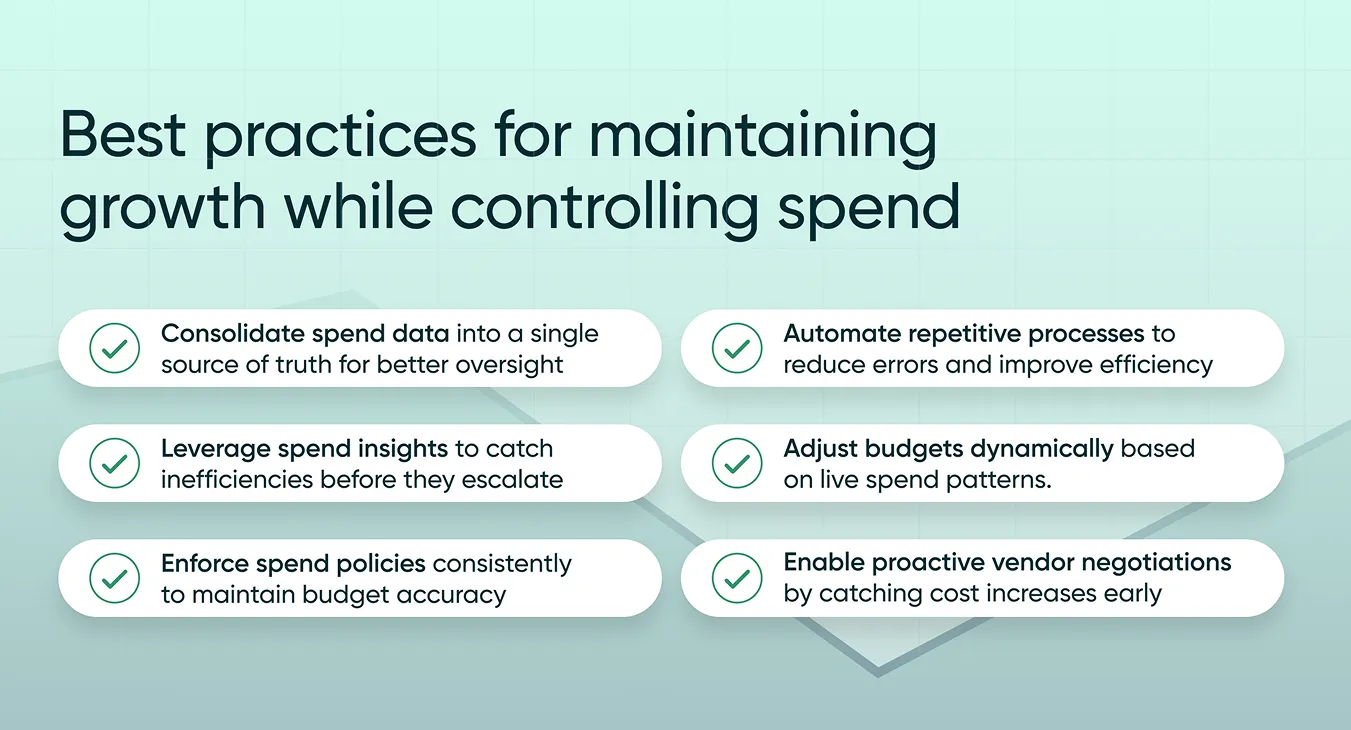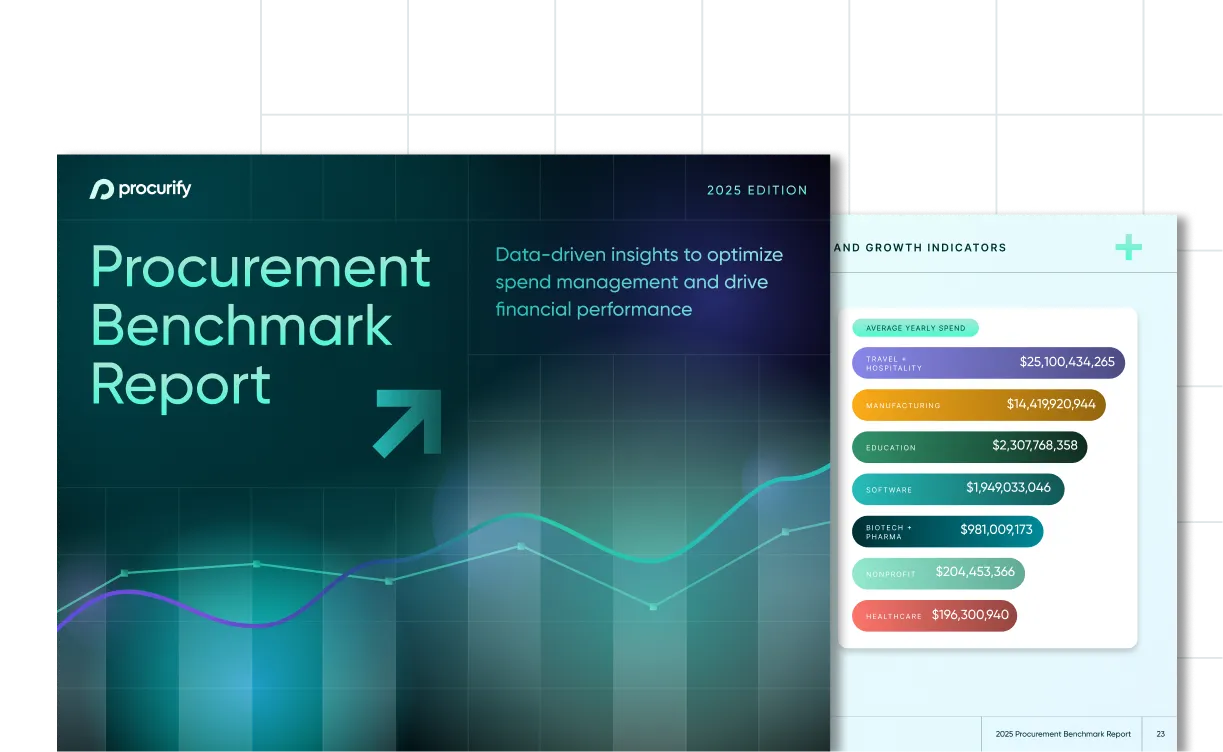
How to Control Company Spending Without Slowing Growth
Controlling company spend isn’t easy, especially when budgets are tighter than ever, and your team is scaling up. Unlike massive enterprises with sprawling finance departments or lean startups with minimal overhead, mid-market companies face a unique challenge: they’re too big to be scrappy but too small to waste a single dollar. Every purchasing decision matters, impacting the bottom line and setting the pace for growth.
Doing more with less has become the new standard. Companies have to be efficient to scale, and more often than not, that means having complete visibility into every dollar spent. That’s where many companies struggle. Organizations are still managing spend with endless spreadsheets, outdated reports, and no real clarity on how spend is happening.
This article will help you understand how cost control and data visibility work together, how better access to spend data can drive growth, and how AI-driven insights and advanced reporting can lead to smarter decisions and stronger business performance.
Cost control vs. cost cutting: Managing company spend
When financial pressures start building, the first instinct for many organizations is to cut costs—freeze hiring, slash budgets, and delay key investments. These moves might ease the strain for a while, but they often come at the expense of long-term growth. The reality is, reacting to financial challenges with blanket cost-cutting is like putting out fires without fixing the spark. It solves the immediate problem but leaves the root cause untouched.
There’s a smarter way. Cost control isn’t just about reducing spend—it’s about managing expenses strategically. It means optimizing each spending category to extract maximum value without sacrificing momentum. Unlike reactive cost-cutting, cost control is intentional. It’s about truly understanding where every dollar is going and making adjustments before small inefficiencies grow into big problems.
This deliberate approach ensures resources are used wisely, priorities are met, and financial stability is maintained, even as the organization scales. By rethinking how money flows through the business, companies can confidently invest in strategic initiatives without overspending. It’s not just about cutting costs—it’s about freeing up capital for impactful projects and unlocking opportunities that drive long-term success.
However, achieving this kind of control takes more than good intentions. Finance leaders need clear, up-to-date visibility into financial operations and spend management. Complete transparency allows companies to protect budgets, optimize resources, and sustain growth by making smarter, data-driven decisions.
Why you need data visibility to control spend
Spend data is rarely in one place. Purchase requests (PRs) might be in procurement software, purchase orders (POs) in ERP platforms, invoices in accounts payable (AP) systems, and approvals lost in email threads. Vendor contracts? Likely scattered across shared drives. This fragmentation creates blind spots that make it nearly impossible to see the full picture—by the time inefficiencies are caught, the money is already spent.
Unified visibility solves this problem by providing a single source of truth. Finance leaders gain a complete view of all spending activities, allowing them to catch off-policy purchases, prevent bottlenecks, and address issues before they escalate. It also streamlines vendor management by centralizing vendor data, making it easy to track key suppliers, monitor spending, and ensure contracts are being followed.
The result? Finance teams spot inefficiencies early, manage cycle times with precision, and optimize spend before it turns into loss. In fact, the 2025 Procurement Benchmark Report shows that companies lose 3–4% of their external spend to inefficiencies, often caused by siloed data. For a company managing $50 million annually, that’s up to $2 million slipping through the cracks—capital that could have been used for growth and innovation.
Why spend analytics drives performance
Every decision about spending affects growth, spend analytics ensures those decisions are the right ones. Clear visibility into spend data creates transparency across departments and better supports scenario planning. This foresight allows them to make adjustments before small issues turn into major financial problems. Decisions are no longer based on assumptions—they are driven by real-time data.
One of the biggest benefits is cost control. When you can see spending as it happens, you can act faster. If vendor costs spike unexpectedly or a department is overspending, you can make adjustments before it impacts the budget. Imagine knowing about a cost overrun when it starts, not weeks or months later. That’s the kind of proactive control that spend analytics makes possible.
It also makes vendor management a lot smoother. With a clear view of spending across all suppliers, it’s easy to identify who’s delivering value and who isn’t. You can see where consolidation might save money or where renegotiating contracts could cut costs. It’s not just about tracking spend—it’s about understanding vendor performance and using that knowledge to drive better deals.
Spend analytics also improves operational efficiency. Approvals happen faster, bottlenecks get resolved quicker, and procurement cycles run more smoothly. It’s easier to spot delays or unnecessary steps, so teams spend less time chasing down information and more time driving value.
How AI powers spend control
When Artificial Intelligence (AI) capabilities are integrated into spend management, it further elevates how finance teams interact with their data. The real power of AI isn’t just speed; it’s contextual understanding.
For example, when you ask a question like “Which suppliers are driving the most costs this month?” or “How did marketing spend compare to last quarter?” AI doesn’t just pull raw numbers—it interprets the data, highlights patterns, and even compares it to historical trends. This means finance teams don’t just see what was spent; they understand why costs are rising, where inefficiencies exist, and what adjustments can be made.
This level of clarity supports forward-looking decisions. By identifying spending patterns as they emerge, finance teams can optimize vendor contracts, adjust departmental budgets proactively, and prevent cost overruns. AI-powered spend analysis unlocks true visibility, enabling finance teams to move from just managing costs to actively optimizing them.
Deploying a reporting tool with AI capabilities ensures teams spend much less time gathering data and more time using it to drive smarter financial decisions.
Best practices to control spend
Controlling spend without stunting growth requires a blend of proactive visibility, strategic planning, and real-time adjustments. Key best practices include:

By adopting these practices, companies can scale confidently without financial friction.
The role of strategic spend management
The companies that lead their markets don’t just manage their spend—they turn it into an advantage. Being on top of where their money is going ensures they can make adjustments faster than their competitors. This isn’t just good financial management, it’s the edge that sets them on the path to success.
When markets shift, prices change, or vendor costs rise, the companies that react first are the ones that protect their margins and keep projects moving. With clear data, finance teams secure better rates, negotiate discounts, and improve contract terms, all while competitors are still scrambling to gather information. While others are tightening their budgets just to stay afloat, you’re putting resources where they can do the most good.
In today’s market, mastering spend management isn’t just about saving money—it’s about staying ahead. With real-time insights and proactive planning, finance leaders can transform spend data into a tool for growth and stability.

2025 Procurement Benchmark Report
Powered by $20B+ in proprietary data you won’t find anywhere else.
